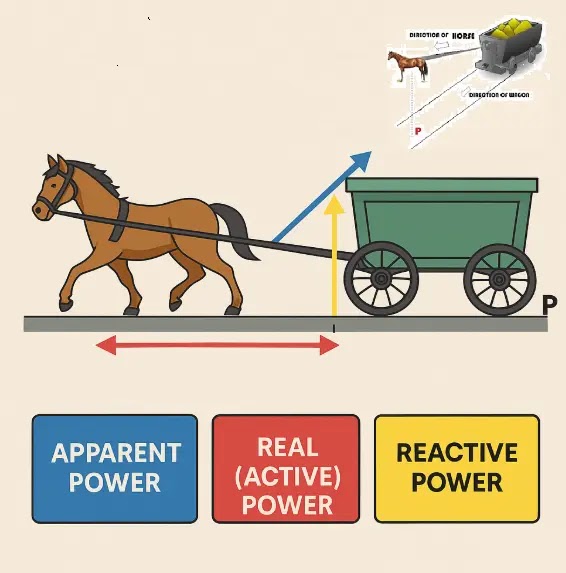⚡ What is Electric Power?
In physics, Power is defined as the rate at which work is done or energy is transferred over time. In simpler terms, power tells us how fast a certain amount of work or energy is being used.
Mathematically,
Power (P) = Work Done / Time
⚙️ Electric Power in Electrical Engineering
In electrical engineering, electric power is the rate at which electrical energy is transferred by an electric circuit. It is calculated using the product of voltage (V) and current (I).
P = V × I
Where:
P = Power (in watts)V = Voltage (in volts)
I = Current (in amperes)
🔄 AC Power: Real, Reactive & Apparent Power
In Alternating Current (AC) systems, electric power is slightly more complex due to the presence of phase difference (ϕ) between voltage and current. So, we divide AC power into three components:
- Active Power (P) – Real power that performs actual work
- Reactive Power (Q) – Power that oscillates between source and load
- Apparent Power (S) – Total power supplied by the source
🐴 Understanding Power with a Simple Analogy
Imagine a horse pulling a wagon:
- In the above figure, a horse pulling a wagon which is placed on the track. When the horse pulled the wagon at some angle of its own direction the wagon change its own position in its own direction as shown in the figure. After pulling the wagon by horse the wagon comes to point P.
- Here the power required for moving the wagon from the initial point to at point P is Real (Active power). The total effort provided by the horse is Apparent Power and the waste power which is the act between the horse and point P is reactive power.
- The total force the horse applies represents the Apparent Power (S)
- The actual forward movement of the wagon is the Active Power (P)
- The sideways or wasted energy (because of the horse pulling at an angle) is the Reactive Power (Q)
This example shows how not all power supplied is useful – some of it just goes back and forth (reactive), while only a part moves the wagon forward (active).
📐 The Power Triangle
The Power Triangle is a right-angled triangle that visually represents the relationship between Active, Reactive, and Apparent power.
Where:
- P = VI cos(ϕ) → Active Power (kW)
- Q = VI sin(ϕ) → Reactive Power (kVAR)
- S = VI → Apparent Power (kVA)
Using trigonometry:
S² = P² + Q²
📌 Definitions of Power Types
✅ Active Power (P):
- Also known as Real or True Power
- Measured in Kilowatts (kW)
- It performs useful work like running motors, lighting lamps, etc.
🔁 Reactive Power (Q):
- Measured in Kilovolt-Amperes Reactive (kVAR)
- It doesn’t do useful work but is necessary for establishing electric and magnetic fields in inductive/capacitive devices like motors and transformers.
📦 Apparent Power (S):
- Measured in Kilovolt-Amperes (kVA)
- It is the vector sum of active and reactive power
- Represents the total power drawn from the source
⚖️ Summary Table
| Type of Power | Symbol | Formula | Unit | Does Useful Work? |
|---|---|---|---|---|
| Active Power | P | VI cos(ϕ) | kW | ✅ Yes |
| Reactive Power | Q | VI sin(ϕ) | kVAR | ❌ No |
| Apparent Power | S | V × I | kVA | Combination of P & Q |
⚡ Electric Power – FAQs
❓ What is Electric Power?
Electric power is the rate at which electrical energy is transferred by an electric circuit. It is typically measured in watts (W) and calculated using the formula P = V × I, where V is voltage and I is current.
❓ What is the formula for Electric Power?
The formula for electric power is:
P = V × I
P = Power in watts (W)
V = Voltage in volts (V)I = Current in amperes (A)
❓ What is the unit of Electric Power?
The SI unit of electric power is the watt (W). Higher units like kilowatt (kW) and megawatt (MW) are also commonly used.
❓ What is the difference between Active, Reactive, and Apparent Power?
- Active Power (P): Real power that performs useful work (measured in kW)
- Reactive Power (Q): Power stored and released but not consumed (measured in kVAR)
- Apparent Power (S): Combination of active and reactive power (measured in kVA)
❓ What is the Power Triangle?
The Power Triangle visually represents the relationship between:
- Active Power (P) – horizontal leg
Reactive Power (Q) – vertical leg
Apparent Power (S) – hypotenuse
❓ What does Power Factor mean in electric power?
Power Factor (PF) is the ratio of active power to apparent power:
PF = P / S = cos(ϕ)
It indicates the efficiency of power usage in an AC circuit.
❓ Why is Reactive Power important if it does no useful work?
Reactive power is essential for creating the magnetic and electric fields needed to operate motors, transformers, and inductors, even though it doesn't do any direct work.
❓ How is power in AC circuits different from DC circuits?
In DC circuits, power is simply P = V × I.
In AC circuits, due to phase difference (ϕ), power becomes:
Reactive Power = VI sin(ϕ)
Apparent Power = V × I
❓ How to reduce Reactive Power in an electrical system?
You can reduce reactive power by:
- Power factor correction using capacitor banks
- Using energy-efficient motors
- Proper system design to minimize inductive loads


